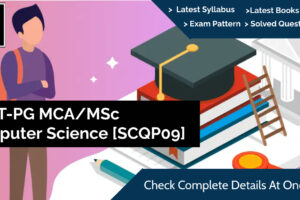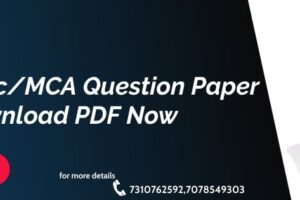CUET-PG Computer Science [SCQP09] Latest Syllabus 2025

The CUET PG MCA/MSc Computer Science [SCQP09] Latest syllabus delves into the core areas of the field, equipping you to tackle theoretical and practical aspects. Imagine navigating a map, with each section representing a crucial domain:
- Foundational Pillars: This section lays the groundwork, covering topics like data structures, algorithms, programming paradigms, and operating systems. Think of it as building a sturdy base for your computational knowledge.
- Programming Proficiency: Dive deeper into specific programming languages, mastering their syntax, data types, control flow, and object-oriented programming concepts. This is where you hone your coding skills and bring your algorithms to life.
- Theoretical Cornerstones: Theoretical computer science forms the backbone of your understanding. Explore topics like automata theory, formal languages, computability, and complexity theory. These concepts unveil the fundamental limitations and capabilities of computation.
- Software Engineering: Learn the art and science of building robust and reliable software systems. This section covers software design principles, testing methodologies, version control, and project management. Think of it as the blueprint for crafting high-quality software.
- Computer Architecture and Organization: Understand the inner workings of a computer, from its basic components like CPU, memory, and I/O devices, to instruction sets and pipelining techniques. This section unveils the hardware behind the software.
Lets Discuss CUET PG New Computer Science Syllabus Chapter Wise-
Note:
i. The Question Paper which will have 75 questions.
ii. All questions will be based on Subject-Specific Knowledge.
iii. All questions are compulsory.
iv. The Questions will be Bilingual (English/Hindi).
Thinking and Decision Making:
Creative thinking, unfamiliar relationships, verbalreasoning, finding
patterns trends and Assessment of figures & diagrams.
• Geometrical designs &Identification
• Selection of related letters / words / numbers /figures
• Identification of odd thing / item out from a group
• Completion of numerical series based on the pattern /logic
• Fill in the blanks of the series based on the numerical pattern and logic of the series
• Syllogisms (logic-based questions), Identification of logic & selection of correct answers based on
thelogic
Mathematics:
• Set Theory: Concept of sets – Union, Intersection, Cardinality, Elementary counting; permutations and
combinations. • Probability and Statistics: Basic concepts of probability theory, Averages, Dependent
and independent events, frequency distributions, measures of central tendencies and dispersions.
• Algebra: Fundamental operations in algebra, expansions, factorization, simultaneous linear /quadratic
equations, indices, logarithms, arithmetic, geometric and harmonic progressions, determinants and
matrices.
• Coordinate Geometry: Rectangular Cartesian coordinates, distance formulae, equation of a line, and
intersection of lines, pair of straight lines, equations of a circle, parabola, ellipse and hyperbola.
• Calculus: Limit of functions, continuous function, differentiation of function, tangents and normal,
simple examples of maxima and minima. Integration of functions by parts, by substitution and by
partial fraction, definite integrals, applications of definite integrals to areas
Computer
- Operating System: Main functions of operating systems, Processes, Threads, Interprocess
communication, concurrency, Synchronization, Deadlock, CPU scheduling, I/O scheduling, Resource
scheduling. Deadlock and scheduling algorithms, banker’s algorithm for deadlock handling. Memory
management and virtual memory. File Systems, I/O systems, DOS, UNIX and Windows. - Data Structure: Arrays and their Applications; Sparse Matrix, Stacks, Queues, Priority Queues, Linked
Lists, Trees, Forest, Binary Tree, Threaded Binary Tree, Binary Search Tree, AVL Tree, B Tree, B+
Tree, B* Tree, Data Structure for Sets, Graphs, Sorting and Searching Algorithms; Hashing. Functions,
Recursion, Parameter passing. - Digital Fundamentals: Data Types, Number Systems and Conversion, Complements, Fixed Point Representation, Floating Point Representation, Error Detection Codes, Computer Arithmetic – Addition, Subtraction, Multiplication and Division Algorithms, Digital Computers, Logic Gates, Boolean Algebra, Map Simplifications, Combinational Circuits, Flip-Flops, Sequential Circuits, Integrated Circuits, Decoders, Multiplexers, Registers and Counters, Memory Unit
Why Should Analysis The Syllabus of CUET-PG Computer Science-
Analyzing the CUET-PG Computer Science syllabus effectively is crucial for your preparation and success in the exam. Here’s a step-by-step approach to help you do it:
1. Familiarize yourself with the syllabus:
- Download the official CUET-PG Computer Science syllabus from the NTA website.
- Read through the entire syllabus carefully, paying attention to the specific topics and sub-topics covered in each section.
- Understand the weightage assigned to different sections or topics, if any.
2. Identify your strengths and weaknesses:
- Assess your current knowledge and understanding of the various topics mentioned in the syllabus.
- Identify areas where you feel confident and those where you need more preparation.
- This will help you prioritize your study time and resources effectively.
3. Break down the syllabus into manageable chunks:
- Divide the syllabus into smaller, more manageable units based on sections, topics, or sub-topics.
- This will make the studying process less overwhelming and allow you to focus on specific areas at a time.
4. Analyze the question pattern:
- Understand the exam format, including the number of questions, marking scheme, and negative marking (if applicable).
- This will help you develop an effective test-taking strategy and answer questions efficiently.
5. Focus on key concepts and problem-solving:
- While covering the entire syllabus is important, don’t just memorize facts.
- Pay close attention to understanding the core concepts and principles behind each topic.
- Practice solving problems and applying your knowledge to different scenarios.
6. Utilize additional resources:
- Supplement your studies with textbooks, study guides, online resources, and previous year’s question papers.
- Take mock tests and practice questions to evaluate your preparation and identify areas for improvement.
- Consider joining a coaching class or online study group for additional guidance and support.
Here are some additional tips for analyzing the CUET-PG Computer Science syllabus:
- Create a study plan: Based on your analysis of the syllabus and your strengths and weaknesses, create a realistic and achievable study plan that allocates sufficient time for each topic.
- Stay organized: Keep your study materials and notes well-organized to avoid wasting time searching for information.
- Take breaks: Studying for long periods can be counterproductive. Take regular breaks to refresh your mind and avoid burnout.
- Stay motivated: Remember your goals and stay motivated throughout your preparation journey.
By following these tips and effectively analyzing the CUET-PG Computer Science syllabus, you can increase your chances of success in the exam and secure your desired postgraduate seat.
How to Prepare for CUET-PG Computer Science [SCQP09] Exam
Preparing for the CUET-PG Computer Science exam requires a focused and strategic approach. Here are some key steps to take:
1. Understand the Exam:
- Syllabus and Weightage: Thoroughly understand the official syllabus and the weightage assigned to different sections. Focus on high-weightage areas and dedicate more time to mastering them.
- Exam Pattern: Familiarize yourself with the exam format, including the number of questions, marking scheme, and negative marking. This will help you develop a strong test-taking strategy.
2. Create a Study Plan:
- Time Management: Plan your study schedule based on the syllabus and your own learning pace. Allocate sufficient time for each topic, considering their weightage and difficulty.
- Revision and Practice: Schedule regular time for revision and practice tests. This will help you solidify your understanding and identify areas needing improvement.
3. Choose your Resources:
- Textbooks and Study Materials: Invest in good quality textbooks and study materials that cover the syllabus comprehensively. Look for recommendations from successful past students or coaching institutes.
- Online Resources: Utilize online resources like video lectures, practice questions, and mock tests available from reliable sources.
- Previous Year Papers: Solve previous year’s question papers and official mock tests to understand the type of questions asked and the level of difficulty.
4. Effective Studying:
- Active Learning: Don’t just passively read or memorize. Actively engage with the material by taking notes, creating mind maps, and solving practice problems.
- Focus on Concepts: While knowledge of facts is important, prioritize understanding the underlying concepts and principles behind each topic. This will allow you to apply your knowledge to different scenarios.
- Clear Doubts: Don’t hesitate to clarify any doubts you have promptly. Ask your teachers, peers, or online forums for help.
5. Additional Tips:
- Join a Coaching Class or Study Group: Consider joining a coaching class or online study group for additional guidance and support. This can also provide a platform for discussing doubts and sharing strategies.
- Maintain a Healthy Routine: Get enough sleep, eat a balanced diet, and exercise regularly. Taking care of your physical and mental well-being is crucial for optimal performance.
- Stay Motivated: Keep your goals in mind and celebrate your achievements, no matter how small. Set realistic milestones and reward yourself for completing them.
By following these steps and staying consistent with your preparation, you can significantly increase your chances of success in the CUET-PG Computer Science exam. Remember, hard work, dedication, and the right approach are key to achieving your desired results.
Frequently Asked Questions CUET-PG Computer Science –
1: What is the syllabus for the CUET PG Computer Science exam?
Ans: The syllabus typically covers subjects such as Algorithms, Data Structures, Operating Systems, Computer Networks, Database Management Systems, Discrete Mathematics, Digital Logic, Programming languages like C, C++, Java, Software Engineering, and more.
Q2: How can I prepare effectively for the CUET PG Computer Science exam?
Ans: Utilize standard textbooks and study materials covering core Computer Science topics. Practice solving previous years’ question papers and take online mock tests to familiarize yourself with the exam pattern and time management.
Q3: What is the exam pattern for the CUET PG Computer Science exam?
Ans: The exam usually comprises multiple-choice questions (MCQs) or objective-type questions, assessing candidates’ understanding of Computer Science fundamentals. The number of questions, marking scheme, and duration may vary each year.
Q4: Are there any specific topics that carry more weight in the CUET PG Computer Science exam?
Ans: While the entire syllabus is crucial, topics like Algorithms, Data Structures, Computer Networks, and Database Management Systems often carry significant weight in the question paper.
Q5: How can I improve my problem-solving skills for this exam?
Ans: Regular practice is key. Solve problems from various resources, engage in coding challenges, participate in online coding competitions, and join study groups or forums to discuss and solve problems collaboratively.
Q6: Is there negative marking in the CUET PG Computer Science exam?
Ans: The exam pattern may include negative marking for incorrect answers. It’s essential to attempt questions you are confident about to avoid losing marks due to incorrect guesses.
Q7: How can I manage my time effectively during the exam?
Ans: Practice time-bound mock tests to enhance your speed and accuracy. Divide your time wisely among different sections based on your strengths and weaknesses. Avoid spending too much time on one question.
Q8: Can I find sample papers or study materials online for the CUET PG Computer Science exam?
Ans: Yes, various educational websites, forums, and online platforms offer sample papers, study materials, and mock tests specifically designed for CUET PG Computer Science aspirants.
| CUET PG Computer Science Books | CUET-PG Computer Science Previous year paper |
| CUET-PG Computer Science Study Tips | CUET PG Computer Science Study Notes |
Tag:cuet computer science, cuet computer science book pdf, cuet pg computer science book, Cuet pg computer science eligibility, Cuet pg computer science pdf, cuet pg computer science previous year question paper, cuet pg computer science syllabus, cuet pg computer science syllabus 2025, cuet pg computer science syllabus pdf, cuet pg political science syllabus pdf, CUET PG Syllabus, cuet pg syllabus for mca



